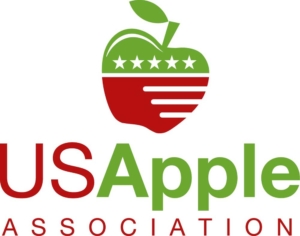The activist Environmental Working Group put out its annual “Dirty Dozen” list, again criticizing the apple industry, which caused US Apple to again denounce the group for putting out “harmful” and “inaccurate” information.
“Any report telling people not to eat fresh produce is beyond silly and potentially very harmful advice,” said USApple President and CEO Jim Bair. “We can all agree that consuming more fruits and vegetables is one of the best things we can do for our health.”

USApple Association logo
EWA annually annually makes an issue of pesticide use in the produce industry, including by conventional apple growers.
Based in Washington, D.C., EWA said:
Many shoppers don’t realize that pesticide residues are common on conventionally grown produce, even after it is carefully washed or peeled. EWG’s analysis of the most recent tests by the Department of Agriculture found that nearly 70 percent of samples of conventionally grown produce were contaminated with pesticide residues.
US Apple issued its response to the latest report:
Falls Church, Va., (April 10, 2018)—The U.S. Apple Association (USApple) is calling the Environmental Working Group’s “Dirty Dozen” list both “inaccurate” and “harmful” to Americans. The report, issued annually, offers consumers an extremely biased view of various fruits and vegetables to avoid based on misleading and flawed reporting by the activist group.
“Any report telling people not to eat fresh produce is beyond silly and potentially very harmful advice,” said USApple President and CEO Jim Bair. “We can all agree that consuming more fruits and vegetables is one of the best things we can do for our health.”
According to USApple, when making dietary choices, consumers should follow the advice of the American Heart Association, American Cancer Society, American Diabetes Association, the U.S. Centers for Disease Control and Prevention, Academy of Nutrition and Dietetics and Dietary Guidelines for Americans, who all say eat more fruits and vegetables.
“USApple’s consumer education efforts focus on science-based reasons to eat more wholesome foods like apples – not less,” said Bair. “The Surgeon General and leading health organizations agree there is far greater health risk from not eating fruits and vegetables than from any theoretical risk that might be posed by consuming trace amounts of pesticide residues. In fact, to exceed the Environmental Protection Agency tolerances, a child would have to eat 154 apples every day.”
According to the CDC, only one in 10 adults get enough fruit and vegetables, putting them at risk for chronic diseases like diabetes and heart disease. Further, a study in the Journal of Food and Chemical Toxicology found that if half of Americans increased their consumption of fruits and vegetables by a single serving each day, 20,000 cancer cases could be prevented annually.
The Environmental Working Group’s “Dirty Dozen” list misleads consumers and is based on inaccurate reporting:
- EWG’s source for its list – the USDA – finds no safety concerns. The U.S. Department of Agriculture report that is the basis for EWG’s latest “Dirty Dozen” notes, “One-hundred percent of the apples sampled through PDP had residues below the EPA tolerances.” The residues are so low, in fact, that an independent toxicological report from Dr. Robert Krieger of the Personal Chemical Exposure Program, University of California, Riverside, found that a small child could eat 154 servings of apples every day without any impact from any residues that might be present.
- EWG’s misleading information affects the health of low income families. Peer-reviewed research published in Nutrition Today shows messaging tactics that invoke safety concerns about non-organic produce may have a negative impact on consumption of fruits and veggies among low income consumers.
- EWG’s report is not peer reviewed. Unlike other health reports submitted to media, EWG’s list is not peer reviewed by an independent body of scientists, academia or other review boards. We encourage media to instead review these four peer-reviewed studies: Journal of Toxicology, Journal of Epidemiology and Community Health, British Journal of Cancer and Journal of Food and Chemical Toxicology.






Leave A Comment